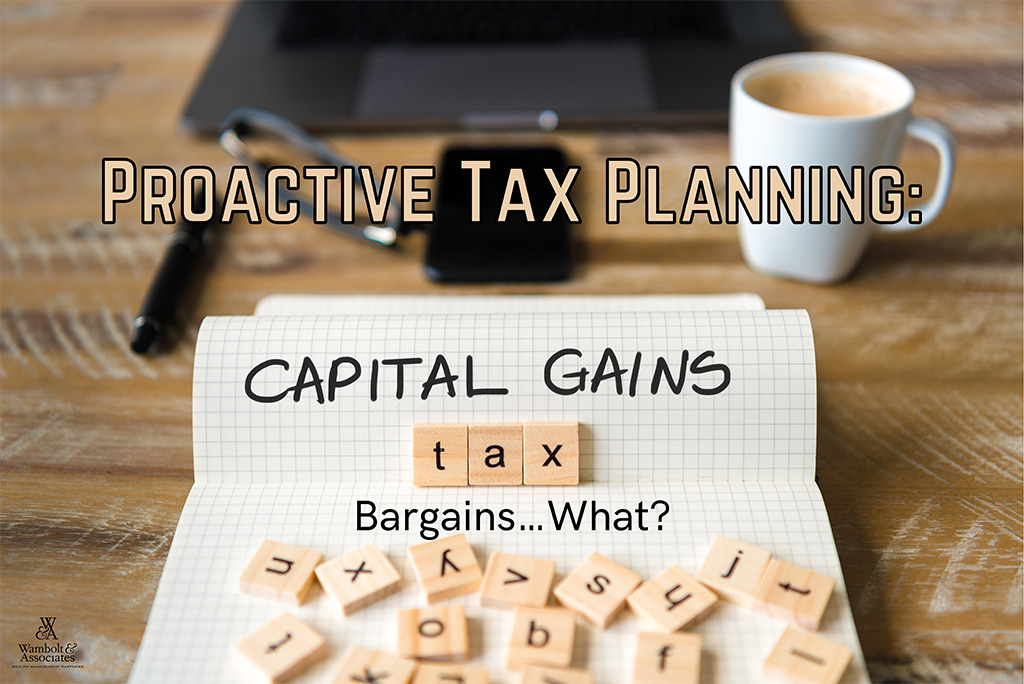By Cindy Alvarez – Senior Wealth Management Advisor
It is usually the fall season when we begin to think about the year coming to an end, and what we might do during this final quarter to improve our tax picture. Simply put, we begin to think about tax deductions. What can we do to decrease the amount we send to the IRS or, better yet, increase the amount of a refund?
We find ourselves encroaching upon the spring and summer seasons and what are we choosing to discuss … proactive tax planning! It might be out of season, but here is our rationale for discussing it now:
Markets are High and Taxes are Low
- There is change in the air as it relates to taxes, and we simply do not know how these proposed tax changes will impact us and when.
- The stock market continues to reach new highs and now is the time to think about strategies that use taxable gains and losses in the portfolio to create opportunity.
The tax code is much more fluid than most realize; where tax deductions and credits come and go all the time. Deductions, like mileage for business owners, changes with the cost of gasoline, it moves up and down annually. Often, it is the actual programs that come and go.
Some programs include energy tax credits or transferring an IRA directly to a charity without paying income tax, yet still satisfying RMD requirements. These programs are often temporary and depending on whether the government believes they have met their objectives, some will expire, and others may become permanent.
Capital gains taxation is one of those laws currently sitting under the microscope. It has changed over the years, being dramatically reduced with the Taxpayer Relief Act of 1997, and while it was intended to be a temporary reduction, it has been extended time and again. These capital gains tax rates have been historically low for over 23 years with only a few small alterations along the way. For most of society, capitalized gains are perceived as taboo and to be avoided at all costs, when in reality, capital gains tax has the ability to positively impact your portfolio and your tax picture.
Let us discuss capital gains as it relates to investments. When you are invested in mutual funds, it is difficult to avoid capital gains. For example, as mutual fund managers buy and sell stocks and bonds within a fund to increase fund performance, tax law requires the net gains be distributed to the shareholders of the fund each year.
Additionally, when investors in a fund want their money back, the fund managers are forced to sell within the fund to raise cash to meet these redemption requests. Winning positions can be sold in the process. In a sense, you are then the taxpayer responsible for capital gains even if you remain fully invested in the fund.
We often like to attribute this to a scenario where you are out for dinner with friends. You order a glass of water and a toothpick while everyone else at the table orders a steak and a glass of red wine. The bill comes and you are all equally responsible.
The root of this example means you have no control over capital gains when invested in mutual funds, and you can be faced with sizeable capital gains distributions at the end of every year. It is one reason to avoid mutual funds in your non-retirement portfolio.
When you own individual stocks and bonds, and even Exchange Traded Funds (ETFs), you get to be in control of your capital gains picture and the ensuing tax. This is when capital gains may turn out to be a totally misunderstood tax bargain. Let us further explain.
As portfolios are reaching all-time highs, especially short-term highs that many investors experienced as soon as the markets began their Covid-19 recovery, locking in some of these gains should be considered. Capital gains tax rates are expected to rise, so you may pay less now than you may in the coming years. If you own solid performing companies in your portfolio and wish to remain a shareholder, after a position is sold, you can buy back the position after 31 days and get a step up in your cost basis. This strategy enables you to control your tax picture for years to come.
What you want to avoid is a concentrated stock position where the cost basis is so low that you are held hostage by the sizeable capital gains that you would realize by selling. Locking in some gains along the way, during periods while the markets are high and the tax rates are low, should be considered. Additionally, for positions in the portfolio that are down or have been slower to recover, you can sell and realize the losses to create a neutral tax picture to avoid tax altogether.
Remember, short term capital gains are realized on sales of positions that have been owned for less than one year. These gains are taxable at your ordinary income tax rate. Long term capital gains are realized on sales of positions that have been owned for one year plus one day, and they are taxed at 15% if your household income is under $425,800. If your income exceeds this limit, your capital gains tax rate jumps to 20%.
Employing any proactive tax planning strategy may sound complicated to do, but working with your professional advisors, both financial and tax, while the markets are still on a roll is quite easy to do. Get a plan in place now when you have extra time to consider the value of taking gains with rates at historic lows and/or stepping up your cost basis. Set parameters for when you will execute the plan, whether immediate or “if” certain market conditions come to bear or, if the current administration begins to initiate change.
Planning is key!


